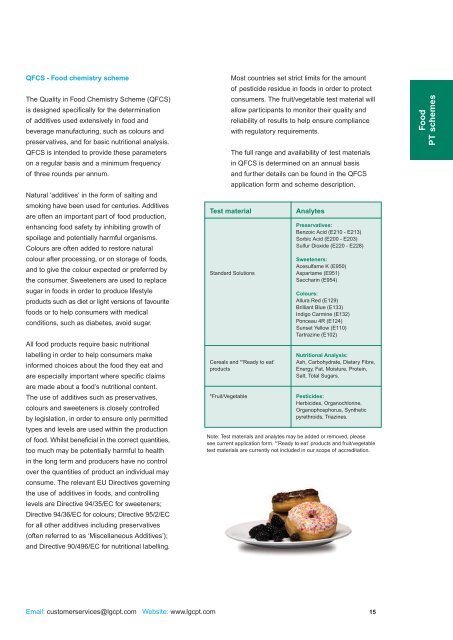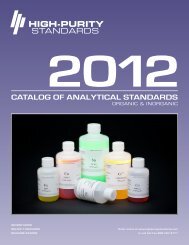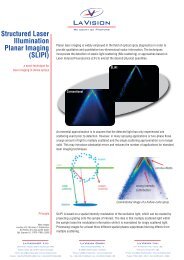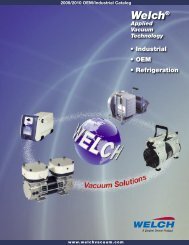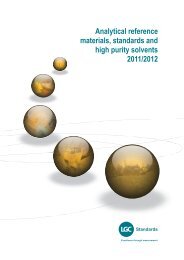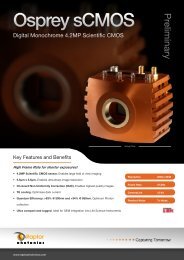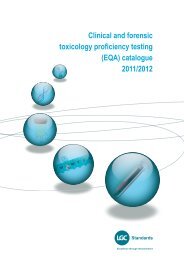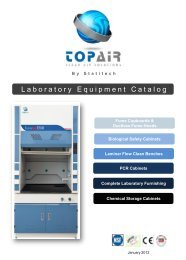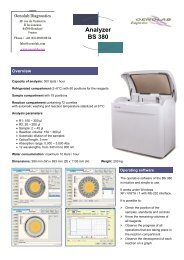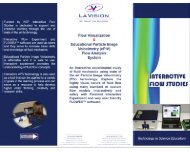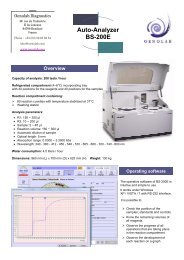Proficiency testing catalogue - LGC Standards
Proficiency testing catalogue - LGC Standards
Proficiency testing catalogue - LGC Standards
You also want an ePaper? Increase the reach of your titles
YUMPU automatically turns print PDFs into web optimized ePapers that Google loves.
QFCS - Food chemistry schemeThe Quality in Food Chemistry Scheme (QFCS)is designed specifically for the determinationof additives used extensively in food andbeverage manufacturing, such as colours andpreservatives, and for basic nutritional analysis.QFCS is intended to provide these parameterson a regular basis and a minimum frequencyof three rounds per annum.Natural ‘additives’ in the form of salting andsmoking have been used for centuries. Additivesare often an important part of food production,enhancing food safety by inhibiting growth ofspoilage and potentially harmful organisms.Colours are often added to restore naturalcolour after processing, or on storage of foods,and to give the colour expected or preferred bythe consumer. Sweeteners are used to replacesugar in foods in order to produce lifestyleproducts such as diet or light versions of favouritefoods or to help consumers with medicalconditions, such as diabetes, avoid sugar.All food products require basic nutritionallabelling in order to help consumers makeinformed choices about the food they eat andare especially important where specific claimsare made about a food’s nutritional content.The use of additives such as preservatives,colours and sweeteners is closely controlledby legislation, in order to ensure only permittedtypes and levels are used within the productionof food. Whilst beneficial in the correct quantities,too much may be potentially harmful to healthin the long term and producers have no controlover the quantities of product an individual mayconsume. The relevant EU Directives governingthe use of additives in foods, and controllinglevels are Directive 94/35/EC for sweeteners;Directive 94/36/EC for colours; Directive 95/2/ECfor all other additives including preservatives(often referred to as ‘Miscellaneous Additives’);and Directive 90/496/EC for nutritional labelling.Test materialStandard SolutionsCereals and *’Ready to eat’products*Fruit/VegetableMost countries set strict limits for the amountof pesticide residue in foods in order to protectconsumers. The fruit/vegetable test material willallow participants to monitor their quality andreliability of results to help ensure compliancewith regulatory requirements.The full range and availability of test materialsin QFCS is determined on an annual basisand further details can be found in the QFCSapplication form and scheme description.AnalytesPreservatives:Benzoic Acid (E210 - E213)Sorbic Acid (E200 - E203)Sulfur Dioxide (E220 - E228)Sweeteners:Acesulfame K (E950)Aspartame (E951)Saccharin (E954)Colours:Allura Red (E129)Brilliant Blue (E133)Indigo Carmine (E132)Ponceau 4R (E124)Sunset Yellow (E110)Tartrazine (E102)Nutritional Analysis:Ash, Carbohydrate, Dietary Fibre,Energy, Fat, Moisture, Protein,Salt, Total Sugars.Pesticides:Herbicides, Organochlorine,Organophosphorus, Syntheticpyrethroids, Triazines.Note: Test materials and analytes may be added or removed, pleasesee current application form. *’Ready to eat’ products and fruit/vegetabletest materials are currently not included in our scope of accreditation.FoodPT schemesEmail: customerservices@lgcpt.comWebsite: www.lgcpt.com15


